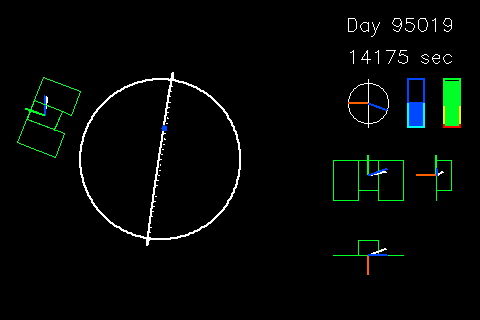
Click on the above still image to go to a page identical to this one but with the animated GIF movie in place of the still. The movie is about 3.4 MB in size; if you would prefer to save it to disk separately, you can use your browser's capabilities and this link to download it directly and skip loading it into your browser.
This is a noon-midnight orbit which crosses the region of the South Atlantic Anomaly in eclipse; the spacecraft pointing strategy is "j-perp", with the ram avoidance constraint in effect. This movie illustrates the complex behavior resulting from the changing requirements imposed by the magnetic field. When the model field magnitude is above 0.3 Gauss, the spacecraft attempts to orient the instrument look direction either antiparallel (northern hemisphere) or parallel (southern hemisphere) to the projection of the magnetic field into the plane normal to the sunline, i.e., the main picture plane, or the plane of the solar panels in the largest of the three static sketches in the lower right of the frame. When the model field magnitude is below 0.3 Gauss, the spacecraft tries to point the instruments perpendicular to the magnetic field, and there is also something that causes the spacecraft to flip 180° when it crosses the geographic equator in the low-field region. I don't know if this is a specific instruction, or if it is trying to keep the projection of the magnetic field into the sun-normal plane to one side of the instruments (over one solar-panel "wing") or the other according to some scheme.
As the movie starts, the spacecraft has been trying to align the instrument look direction and the projection of the magnetic field vector, but is prevented from doing so by the ram-avoidance constraint (note that if the spacecraft rotated so that the magnetic-field condition was satisfied, the instruments would be looking almost directly along the white ram vector). At the ascending node (i.e., as the spacecraft enters into the northern hemisphere at the start of the movie), this target condition reverses, so the spacecraft rotates to anti-align the instrument look direction and the projected field vector. It overshoots slightly, but recovers and stabilizes (so that "pseudo-coast-mode" is entered and my program erroneously colors the spacecraft yellow) by 14481 seconds UT. The spacecraft then rotates to follow the rotation of the projected magnetic field, with an interruption from the ram-avoidance constraint from about 14703 to 15141 sec. It passes into eclipse while aligned thus, entering (true) coast mode (when the rightmost bar gauge enters the yellow zone) from 15957 to 16689 sec. During this period the magnetic field rotates roughly in the plane of the orbit, but the spacecraft can't do anything about this while in coast mode, and upon exiting coast mode it finds that the projection of the field into the sun-normal plane is almost opposite where it should be. It begins rotating to correct this, but 36 seconds later (16725 sec) the field magnitude drops below 0.3 Gauss and the target changes to j-perp.
The spacecraft rotates to point the instruments perpendicular to the field, but overshoots; before it can correct this, it enters the southern hemisphere (around 17000 sec) and it rotates 180° to place the magnetic field projection over the other solar panel "wing". It again overshoots, but enters coast mode again at 17331 sec before it can correct. Coast mode ends when the spacecraft emerges from eclipse at 17757 sec, by which time the instruments are no longer pointing nearly normal to the field; it corrects this, then the field magnitude rises above 0.3 Gauss at 18165 sec, so the instrument look direction has to be moved parallel to the projected field vector again. The spacecraft then rotates to follow the field, until it runs into the ram constraint again at about 19443 sec; the end of the orbit finds the spacecraft (not surprisingly) in the same situation as the beginning.
The overall picture here is that the poor spacecraft is having changing conditions and requirements (field magnitude and direction, hemispheric targets, coast mode) thrown at it just about as fast as it can deal with them, and sometimes faster. Ignoring the overshoots that are a natural consequence of its having to make large rotations quickly, however, it appears to be behaving just as it was programmed to do; all the twists and turns we have seen in the attitude data are there for a reason.
 To
next movie (orbit 13854)
To
next movie (orbit 13854) Back
to top of Attitude Movies
Back
to top of Attitude Movies Back
to top of Data Pages
Back
to top of Data Pagesnew 9 March 1999